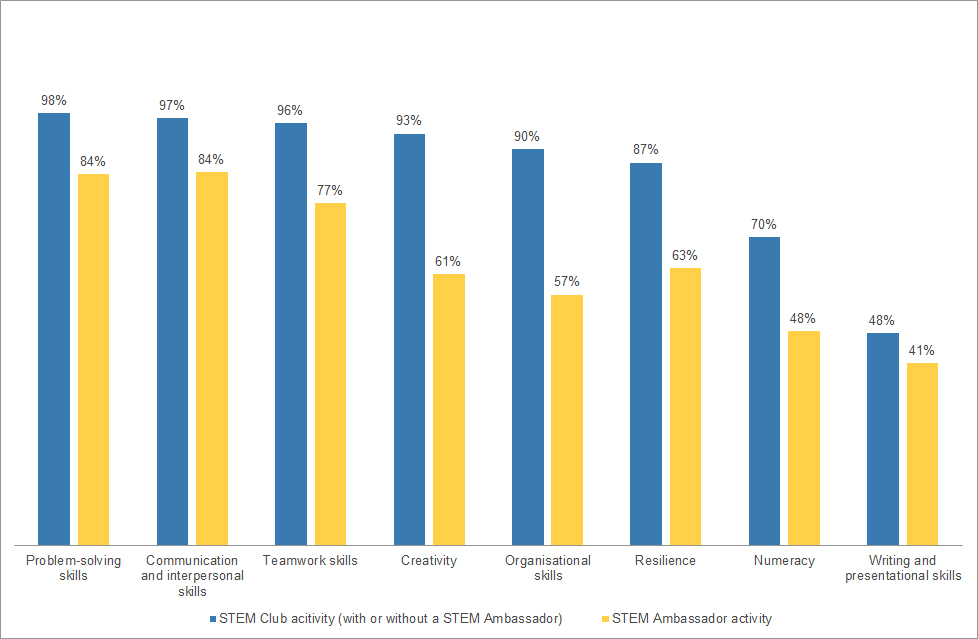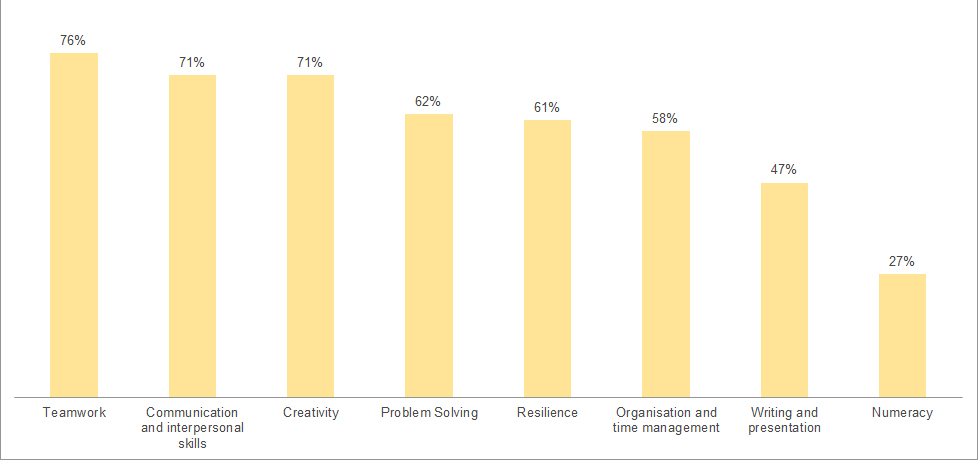Improving young people's employability
27 Sep 2016
Rosa Marvell, IES Research Fellow
 Recent work by IES, commissioned by STEMNET[1] and funded by the Department of Business, Innovation and Skills, has highlighted the positive effect[2] of STEMNET’s programmes on young people’s employability skills[3]. This provides an opportunity to consider ‘what works’ in preparing pupils for effective labour market and educational transitions.
Recent work by IES, commissioned by STEMNET[1] and funded by the Department of Business, Innovation and Skills, has highlighted the positive effect[2] of STEMNET’s programmes on young people’s employability skills[3]. This provides an opportunity to consider ‘what works’ in preparing pupils for effective labour market and educational transitions.
Focusing on employability skills for young people is critical. These skills are important not only in enabling young people to enter and succeed in employment, but also in terms of transitions to Further and Higher Education. However, their development is complex; employability is not simply about possessing a range of transferable skills and personal attributes. People can develop skills without recognising them, may not understand their relevance to employment or feel unsure about how to present these capabilities to others. This disconnect is particularly relevant for young people with no labour market exposure.
Our research[4] considered two programmes: STEM Ambassador and STEM Club activities. STEM Ambassadors are professionals who use STEM skills in their work, volunteering to support the young people’s STEM education. Activities include one-off talks, curricular and extracurricular support or workplace visits. STEM Clubs are extra-curricular sessions where pupils explore elements of STEM through engaging topics and formats such as practical experiments, investigations or competitions.
The impact of STEMNET’s programmes
Surveyed teachers and pupils clearly agreed that STEM Ambassador and STEM Club activities improve young people’s employability skills and, to a somewhat lesser degree, employability attributes (see Figure 1 and Figure 2). Of particular note are prominent benefits around teamwork, problem-solving, communication and creativity and the particularly positive picture surrounding STEM Clubs, which are more practical and hands-on.
Figure 1: Proportion of teachers who agreed that STEMNET’s programmes develop young people’s employability skills

Source: Teacher survey, IES 2015.
Figure 2: Proportion of pupils who reported their employability skills had improved ‘a lot’ or ‘quite a bit’ from STEM Club and STEM Ambassador activities

Source: Pupil survey, IES 2015
Positive impacts were not restricted to STEM sessions. Interviewed teachers identified wider behavioural changes, where previously shy or adrift students became more ‘inquisitive’, ‘curious’, ‘engaged’ and ‘articulate’ in the classroom.
Discussions about employability attributes (eg personal qualities) were less frequent; some pupils felt these were more obscure than skills such as teamwork or problem-solving, although there were some exceptions. Pupils believed they valued diversity and difference more, whilst teachers (especially those in more disadvantaged schools) identified improvements in resilience and confidence. Despite these gains, surveyed teachers felt pupils may not be able to identify the full extent of their new capabilities. Reflective activity was a key mechanism to improve this, although teachers emphasised the time pressures they were under and how this curtailed their engagement levels. Activities involving STEM Ambassadors exerted a particularly positive effect on developing an understanding of the world of work. Surveyed teachers reported that meeting industry professionals linked the curriculum to real work applications (92%), improved awareness of diverse STEM careers (87%) and improved understandings of the realities of a work environment (69%). Formal, substantive events (eg careers fairs/workplace visits) had notably positive effects for pupils. However, informal conversations were also valuable channels which demystified occupational trajectories and higher, further or vocational education options.
However, there were fewer examples of students evidencing their employability skills. Likewise, most pupils surveyed felt ‘somewhat’ confident they would be able to do so. Despite limited findings, national certifications and presentations were seen as particularly effective opportunities for students to articulate their learning journey.
How do STEMNET’s programmes achieve an impact?
For practitioners and policy-makers hoping to better prepare young people for post-secondary transitions and imbue them with a suite of ‘soft’ skills, the possible reasons behind these positive benefits provide a useful starting point:
- Many pupils already had an underlying interest in the topic matter, and activities were often organised such that students opt in or are selected due to their existing interest. Capitalising on this existing interest maximises the learning that students can take from the activity.
- STEM Ambassadors themselves felt it was important that pupils had a degree of choice, as engagement could be dampened where students were required to attend.
- Group sizes were often – but not always – small, which allowed pupils to receive more attention and development opportunities, although this could place significant limitations on the reach of a particular activity.
- Teachers often described their facilitation style as ‘hands-off’, which can let pupils take ownership of activities and follow them from start to finish.
- Competitions are said to be greatly motivating and can help to keep the momentum behind an activity – particularly so when this is related to national or international competitions as they can be championed in school. Pupils themselves explained that elements of real competition convince them to expend greater time and energy.
- STEM Ambassadors emphasised the need to avoid formulaic activities or others too similar to a ‘traditional’ academic programme of study and to choose activities which are practical, creative and hands-on.
- Ongoing projects lasting from several weeks to the duration of the academic year promote continuous reflection and learning. Teachers and stakeholders alike believed the impact on employability skills is one that gradually accrues; they therefore valued activities which required continuous and sustained engagement.
- Following up learning – even in very informal ways – can help to cement learning and make outcomes clearer and more explicit.
What challenges remain?
Despite emergent positive findings which have been clearly recognised by teaching staff, industry professionals and learners, a number of challenges remain for those delivering STEMNET’s programmes ‘on the ground’. These include:
- Time: For teaching staff, delivering these activities (particular external visits) and finding time within that to focus on employability skills can be under strain from broader pressures of curriculum delivery and raising attainment.
- Lack of peer support: Some teachers felt they were a solitary voice pushing activity forward, and there was a risk to sustainability of activities if these ‘champions’ moved on.
- Student behaviours or beliefs: STEM Ambassadors and young people felt that a few pupils with low self-esteem or confidence could behave badly, have low attendance or disengage from tasks (especially in challenging moments), limiting the benefits they could derive. Contrastingly, some teachers felt students could be instrumental and view the activity as something to put on a CV or personal statement, rather than an opportunity for wider development.
Conclusions
Our findings indicate there is real strength in the diversity of STEMNET’s programmes. Longer-term STEM Clubs, projects and competitions build a whole suite of employability skills whilst one-off activities can increase insights into the world of work. STEM Ambassador activities are particularly valued for the ways in which they raise awareness about the world of work, career pathways and real day-to-day lives at work. As this research shows, there is real value in allowing pupils the opportunity to explore future careers in applied settings.
Footnotes
[1] The Science, Technology, Engineering and Mathematics Network http://www.stemnet.org.uk/
[2] It must be noted that this research captures information on perceived rather than demonstrable impacts, since the method did not involve any counterfactual assessment. Despite this, the findings provide a detailed insight into the benefits perceived by a range of important stakeholders who have significant experience of involvement.
[3] Primarily in Key Stage 3 and 4
[4] Marvell R, Newton B (2016), The impact of STEM programmes on young people’s employability skills, STEMNET

